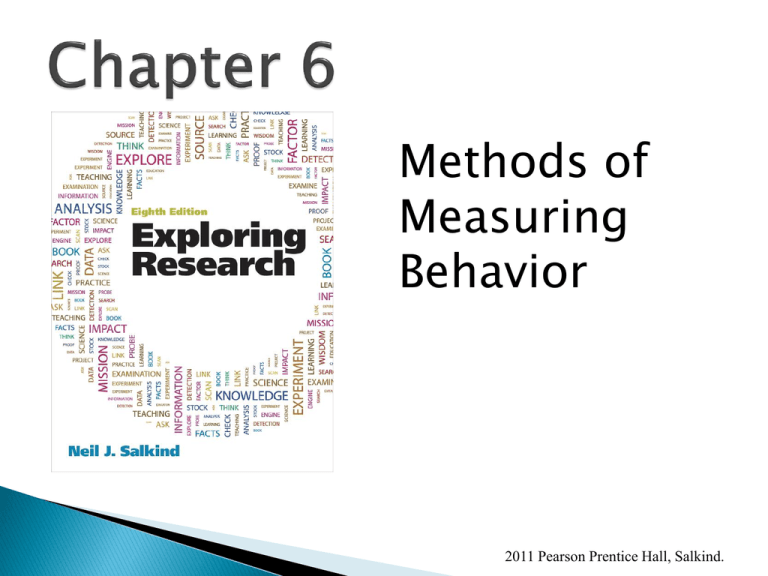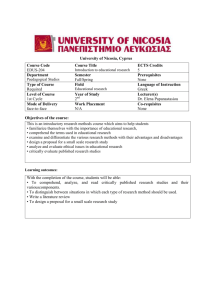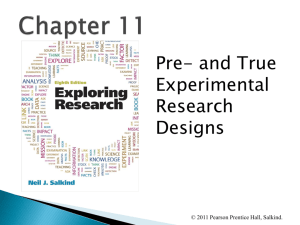
Methods of
Measuring
Behavior
2011 Pearson Prentice Hall, Salkind.
Tests and Their Development
Types of Tests
Observational Techniques
Questionnaires
2011 Pearson Prentice Hall, Salkind.
Is the tool you propose to use reliable and
valid?
Base your choice of research tools on how
you have asked the research question.
2011 Pearson Prentice Hall, Salkind.
List five reasons why tests are useful.
Discuss the various types of tests and how they are used.
Conduct an item analysis identifying the discrimination and
difficulty indices for each item in a test.
Explain the difference between the discrimination index
and the difficulty index.
List the various techniques used to record behavior.
Write questions using a Thurstone scale and a Likert scale.
List the factors to consider in order to make questionnaires
successful.
2011 Pearson Prentice Hall, Salkind.
2011 Pearson Prentice Hall, Salkind.
A test should measure the nature and extent
of individual differences
A good test differentiates people based on
their true scores
2011 Pearson Prentice Hall, Salkind.
To help determine outcomes of experiments
To diagnose strengths and weaknesses
To assist in placing individuals in appropriate
programs
To assist in selecting applicants
To evaluate a program’s effectiveness
2011 Pearson Prentice Hall, Salkind.
2011 Pearson Prentice Hall, Salkind.
What It Does
Achievement Test
Assesses an individual’s knowledge of a
specific area
Attitude Test
Assesses an individual’s feelings about an
issue
Personality Test
Assesses stable individual behavior patterns
2011 Pearson Prentice Hall, Salkind.
Standardized
◦ Commercially prepared for wide use
◦ Scoring instructions included
Researcher/Teacher-made
◦ Designed by user for specific purpose
◦ Scoring instructions specific to test
2011 Pearson Prentice Hall, Salkind.
Norm-referenced—individual’s scores are
compared to results from a larger group
Criterion-referenced—individual’s scores
are compared to defined performance
standards
2011 Pearson Prentice Hall, Salkind.
12. Intelligence tests that are given to
preschool children
a. favor middle-class children
STEM
Clearly written
CORRECT
ANSWER
b. have questionable construct validity
c. are based on motor skills
d. are no fun at all
DISTRACTERS
Should be plausible (b & c), not easily ruled out (d)
2011 Pearson Prentice Hall, Salkind.
Advantages
Versatile
Easy to score
Simple to take
Poor writers not
penalized
◦ Good items used
again
◦ Good distracters are
diagnostic
◦ Hard to fake correct
answer
◦
◦
◦
◦
Disadvantages
◦ Limit student’s
options
◦ No opportunity to
practice writing
◦ Some people don’t
do well on them
◦ Limits content to be
assessed
◦ Items must be well
written
2011 Pearson Prentice Hall, Salkind.
Questions should discriminate those who
know the material from those who don’t
Item analysis provides two measures of a
question’s ability to discriminate
◦ Difficulty index
◦ Discrimination index
2011 Pearson Prentice Hall, Salkind.
1.
Rank scores from highest to lowest
2.
Choose top 27% of scores for “high” group
3.
Choose bottom 27% of scores for “low” group
2011 Pearson Prentice Hall, Salkind.
12. Intelligence tests that are given to preschool children
a. favor middle-class children
b. have questionable construct validity
c. are based on motor skills
d. are no fun at all
Item Alternative
A
B
C
D
Total
High Group
(n = 41)
23
12
4
2
41
Low Group
(n = 41)
11
9
15
6
41
Total
34
21
19
8
82
2011 Pearson Prentice Hall, Salkind.
Difficulty index
Proportion who
answered item
correctly
D = NCh + NCl
T
Discrimination index
Proportion in high
group who answered
correctly minus
proportion in low
group who answered
correctly
D = NCh - NCl
(.5)T
NCh = number of people in high group answering correctly
NCl = number of people in low group answering correctly
T
= total number of people in high and low groups
2011 Pearson Prentice Hall, Salkind.
Discrimination Level
+1.00
0
50%
0%
Perfect
discrimination
when:
½ gets item
right,
½ gets item
wrong
&
100%
½ right is in
upper half,
½ wrong is in
lower half
-1.00
Difficulty Level
2011 Pearson Prentice Hall, Salkind.
2011 Pearson Prentice Hall, Salkind.
Statements are written indicating an attitude
toward a topic
Judges rank the statements from least
favorable to most favorable
Statements receiving consistent ratings are
given the average score
A set of statements is selected that covers the
entire range of attitudes
2011 Pearson Prentice Hall, Salkind.
Respondents check items with which they
agree
◦ Well-formed attitudes are indicated by consistently
checking either high or low items
◦ Poorly-formed or inconsistent attitudes are
indicated by inconsistent patterns or by checking
off many neutral items
2011 Pearson Prentice Hall, Salkind.
Statements are written indicating an attitude
toward a topic
Items with clearly positive or negative
attitudes are selected
Statements are listed with a space for
respondent to indicate degree of agreement
2011 Pearson Prentice Hall, Salkind.
Directions: Indicate to what extent you agree or disagree with the statements
listed below by circling one of the following:
SA means that you strongly agree with the statement (value = 5)
A means that you agree with the statement (value = 4)
U means that you are undecided about the statement (value = 3)
D means that you disagree with the statement (value = 2)
SD means that you strongly disagree with the statement (value = 1)
Item
Rating
Government has no business funding
child care programs.
SD
D
U
A
SA
Child care should be supported by
federal, state, and local tax dollars.
SD
D
U
A
SA
2011 Pearson Prentice Hall, Salkind.
Item
Rating
Government has no business funding
child care programs.
SD
D
U
A
SA
Child care should be supported by
federal, state, and local tax dollars.
SD
D
U
A
SA
Items are weighted
Weights of unfavorable items are reversed
Average score is computed
2011 Pearson Prentice Hall, Salkind.
Projective tests
◦ Present respondent with ambiguous stimulus
Structured tests
◦ Questions are objective
2011 Pearson Prentice Hall, Salkind.
2011 Pearson Prentice Hall, Salkind.
Researcher observes and records
Does not interfere with behavior
2011 Pearson Prentice Hall, Salkind.
Technique
How it Works
Example
Duration recording
The researcher records
the length of time that a
behavior occurs.
How much time is spent
in verbal interaction
between two children?
Frequency recording
The researcher records
the number of times a
behavior occurs.
How often are questions
asked?
Interval recording or
time sampling
The researcher observes
a subject for a fixed
amount of time.
Within a 60-second
period, how many times
do members of the group
talk to another person?
Continuous recording
The researcher records
everything that happens.
During a 1-hour period, all
the behavior of a 6-yearold boy is recorded.
2011 Pearson Prentice Hall, Salkind.
Observer effects
Observer bias
Fatigue
Changing definitions
2011 Pearson Prentice Hall, Salkind.
2011 Pearson Prentice Hall, Salkind.
What they are
◦ Paper and pencil tests with structured questions
◦ Self-administered
2011 Pearson Prentice Hall, Salkind.
Advantages
◦ Can be mailed out
◦ Can be done online
(www.surveymonkey.com, www.zoomerang.com and
www.surveygizmo.com among others)
◦
◦
◦
◦
Survey broad geographic area
Cheaper than one-on-one interview
Respondents may be more honest
Data easy to share with other researchers
Disadvantage
◦ Low return rate
2011 Pearson Prentice Hall, Salkind.
Does not make unreasonable demands upon
the respondent
Does not have a hidden purpose
Requests information that respondents
presumably have
Contains interesting questions
Does not request information that could be
obtained by other means
2011 Pearson Prentice Hall, Salkind.
The questionnaire contains questions that
can be answered
The questionnaire contains questions that are
straightforward
2011 Pearson Prentice Hall, Salkind.
The presentation is attractive, professional, and
easy to understand
Questions and pages are clearly numbered
Directions are clear and explicit
Questions are objective
Questions are ordered sensibly
Transitions are used from one topic to the next
Examples are given when necessary
2011 Pearson Prentice Hall, Salkind.
Informs the recipient about the research
Establishes the importance of the research
Makes the recipient a part of the research
2011 Pearson Prentice Hall, Salkind.
List five reasons why tests are useful?
Discuss the various types of tests and how they are
used?
Conduct an item analysis identifying the discrimination
and difficulty indices for each item in a test?
Explain the difference between the discrimination index
and the difficulty index?
List the various techniques used to record behavior?
Write questions using a Thurstone scale and a Likert
scale?
List the factors to consider in order to make
questionnaires successful?
2011 Pearson Prentice Hall, Salkind.









